Bananas are some of the most versatile plants in Syntropic farming.
They protect fragile seedlings and provide abundant mulching material (biomass) and tasty fruits, earning them the nickname “mother” in some regions.
However, there are some key things to know to successfully grow and manage bananas in a Syntropic garden.
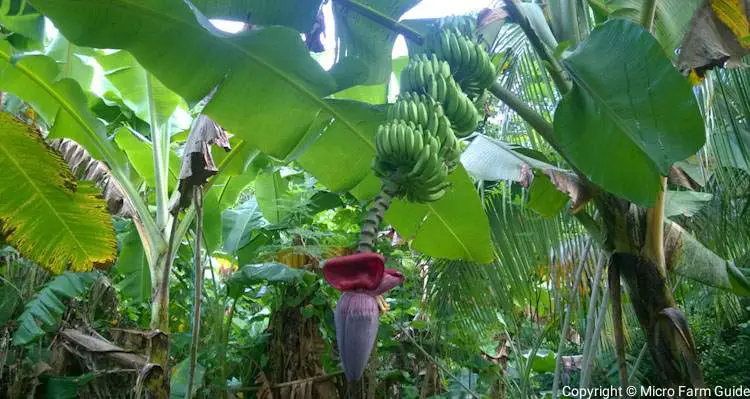
In this article, we will take a look at:
- How To Choose Banana Plants For Your Syntropic Garden
- Plant Spacing For Bananas In Syntropic Farming
- How To Plant Bananas In Syntropic Agroforestry
- How To Take Care Of Young Banana Plants
- How To Harvest And Remove Banana Plants
How To Choose Banana Plants For Your Garden
There are many varieties of bananas, making choosing a bit overwhelming. Fortunately, these belong to two main categories; plantains; for cooking, and bananas, which you can eat when ripe.
Ideally, you should pick varieties that you enjoy eating and are well adapted to your local growing conditions.
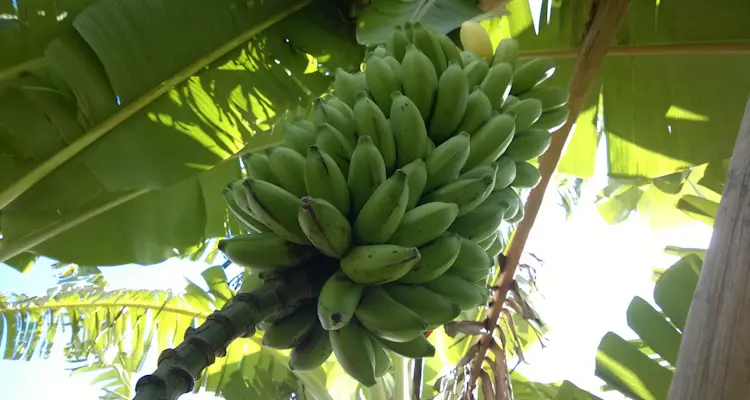
You may wish to consider local varieties instead of hybrids or imports; they are more resilient to local climate, as well as pests and diseases in your area.
You can find information on available varieties at your local agriculture extension office or nursery.
However, if you want to find true hidden gems, talk to farmers or gardeners in your area; some are even willing to share rare “native” plants.
Note: The bananas grown in our garden were initially planted over 60 years ago on the property! We were tempted to get dwarf varieties when planning our garden but decided against it; since the taller local varieties create an ideal environment for our other plants.
Plant Spacing For Bananas In Syntropic Farming
The minimum spacing for bananas in a Syntropic system is 3 meters or about 10 feet between plants. This allows enough space for the suckers to grow while permitting enough light to reach other plants.
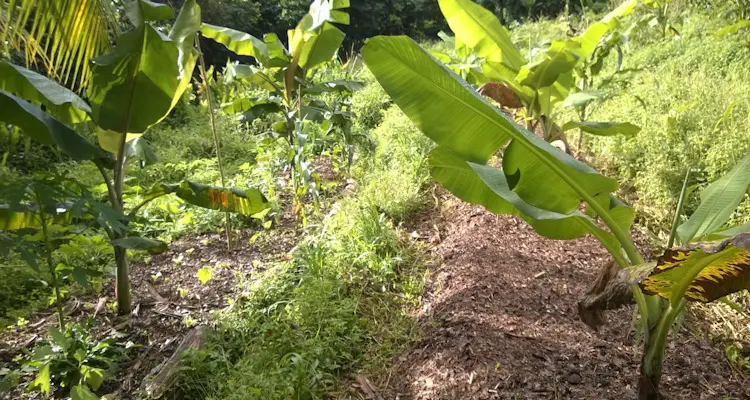
When planning your garden, you can start by marking out the position of the banana plants. They grow well with most crops and can be pruned if they cause a hindrance.
According to Mr. Götsch, the creator of the Syntropic Agroforestry System, you can never plant too many bananas in your garden.
Remember, bananas are forest plants that thrive in partial shade. However, they are prone to fungal disease if the airflow is restricted.
Note: We spaced the plants about 6 feet apart in our first banana trial plot. We later increased to 12 feet spacing for our Syntropic garden, growing various crops.
How To Plant Bananas In Syntropic Agroforestry (Step By Step)
An established banana stool supports the plant as it bears the weight of the fruit and endures strong winds.
You can encourage this mat formation by following the step below.
1. Choose Healthy Planting Material
You want to get the healthiest banana plants you can find to use as your “seed” plants. Ensure they are free of disease and thriving.
Ideally, select plants that are already well developed but have not produced fruit yet. Avoid young or underdeveloped suckers.
Carefully uproot these plants to clear away excess soil. Inspect the root or signs of rot or disease.
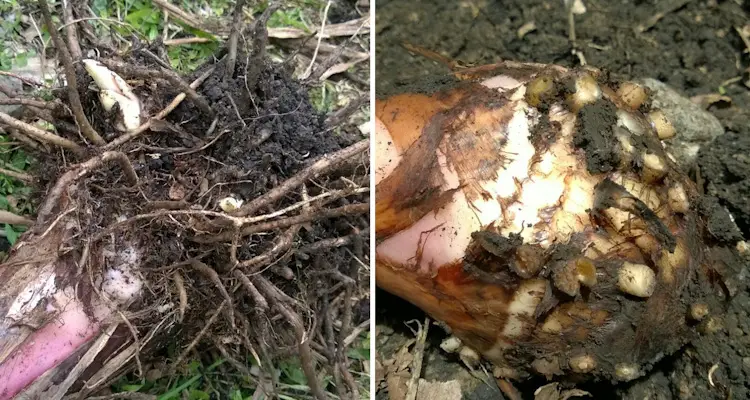
2. Prepare Banana “Seed” For Planting
Remove the root hairs from the rhizome of the plant.
In theory, trimming the root hair stimulates new roots when planted.
Separate the rhizome from the stem with a clean-cut, using a machete (cutlass).
Now that you have your “seed,” it is time to plant.
Note: The rhizome is the part of the banana plant found underground, from which suckers and roots grow.
3. Create A Nest And Plant The Seed
Carefully remove the mulch and topsoil, placing this around the hole in the location you intend to plant.
Dig a shallow hole about 4 inches deeper than the width of the rhizome. You can add compost or other amendments if you wish.
Place the “seed” on its side, with the cut part at an angle, facing slightly downward.
Cover with the soil and mulch, gently pressing to remove air pockets.
Mark the nest with a stick and water.
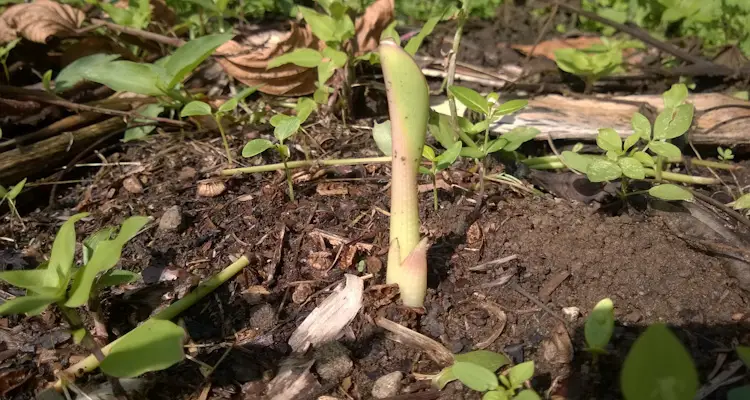
Note: A planting hole in Syntropic Agroforestry is often called a nest. This name is the preference of Mr. Ernst Götsch, who associates holes with death, but nests with life.
How To Take Care Of Young Banana Trees
The care of Banana plants in a Syntropic garden usually equates to irrigation and pruning.
Irrigation:
Banana plants are made up mainly of water, growing limp and possibly toppling over if there is a lack.
Young plants need to receive enough water to sustain their growth. Ideally, the soil should remain relatively moist but not soggy.
You can do this by providing a source of water during dry spells or by retaining moisture in the soil through mulching.
Pruning:
Banana plants are revered as valuable sources of biomass. However, if left unchecked, the excess foliage creates perfect conditions for pests and disease.
As a precaution, it is necessary to remove dried and dying leaves when possible to allow proper airflow.
Over time, suckers will emerge from beneath the plant, allowing them to grow initially.
Once the suckers reach three feet tall, identify the two most robust plants and remove the others, leaving a stool of three plants at different stages of development.
You can transplant the suckers or use them as mulch. Use this time to seed the health of the banana plants in your system.
Note: Please use a clean, sharp machete when pruning the banana plants. If you encounter any sign of disease, foul odors, rotting stems, etc., ensure you clean the cutlass to avoid spreading.
How To Harvest And Remove Banana Plants
Bananas are harvested by separating the entire bunch from the plant. This usually includes cutting the stem of the plant to reach the fruit.
However, on shorter plants, you can unhand individually. In doing so, you can enjoy bananas at different stages of development.
Once harvested, remove the plant from the stool as follow:
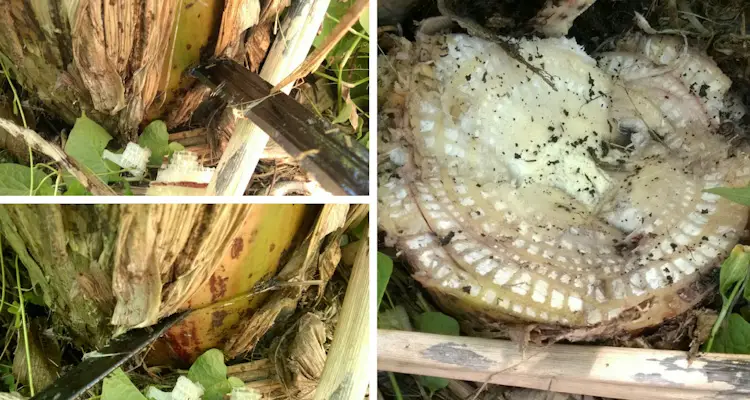
- Cut the stem about waist height.
- Using a machete, spit down the middle of the plant until you reach the base.
- Insert the machete into the base of the plant and slice across, repeating until the stem is separated from the rhizome
- Cut the leaves and stem into smaller pieces and use them to mulch plants or create borders in the garden.
You will notice more light and air entering the area by removing the plant. This stimulates the growth of the young suckers and neighboring plants.
Note: In Syntropic Agroforestry, we cut the banana plant to the base, forming a bowl shape. Shortly afterward, sap from the plant covers the area, protecting it from pests and disease.
Final thoughts
Banana plants are valuable to any tropical Syntropic garden system, requiring minimal management to yield an abundance of fruit.
Surprisingly, some people grow bananas solely for their biomass and ability to create a suitable environment for young seedlings.
However, care must be taken when selecting varieties and where you intend to grow them.
By spending a few extra minutes planning your garden, you can enjoy a bountiful harvest of tasty bananas for years to come.
Related Questions
How Long Do Banana Plants Take To Produce Fruit?
Banana plants can take between 12 to 24 months to produce their first fruit based on the variety and growing conditions. Afterward, you can expect to get fruit from the same stool once or twice per year.
Do Banana Plants Prefer Shade Or Full Sun to Grow?
While Banana plants are often grown in full sunlight, they are best suited to grow in partial shade. Their large leaves are well adapted to collect dappled sunlight as they filter through the canopies of taller trees.
References
Global Freedom Project. Syntropic Farming Guidebooks. global-freedom-project.org. Accessed January 2022
Agroforestry School. How To Plant Bananas In an Agroforestry System. [Video]. YouTube. Uploaded June 24, 2019
Agroforestry School. How To Prune Bananas. [Video]. YouTube. Uploaded June 6, 2021

